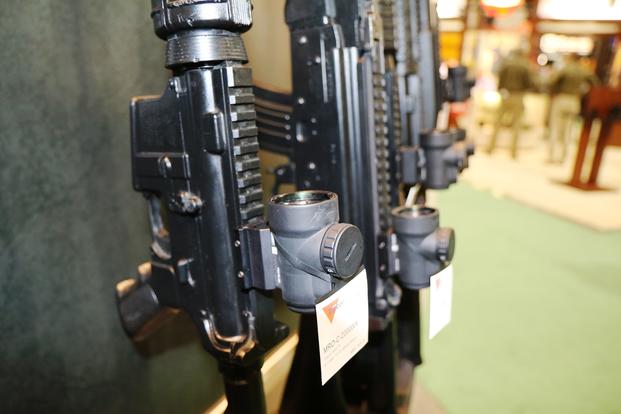LAS VEGAS -- In the months after EOTech Inc. settled a lawsuit over defective sights, competitors say they're vying for more market share amid a shakeup in the industry.
Companies such as Trijicon Inc., based in Wixom, Michigan, and Aimpoint AB, based in Malmo, Sweden, say customers in the U.S. military and law enforcement markets are reaching out to them in large numbers to inquire about their products in the wake of EOTech's settling of a lawsuit that accused the company of knowingly selling optics that failed in extreme temperatures and humid weather conditions.
Chuck Wahr, vice president of sales and marketing at Trijicon, described it as a "watershed moment."
"Precision is very important," he said in an interview on Wednesday here at SHOT Show, the biggest trade show for the small arms industry. "People know us for those things and our military and law enforcement customers again know who we are and are helping us build a watershed moment in the marketplace as people move from less dependable solutions."
Referring to the Trijicon's recent release of a new tactical optic, the Miniature Rifle Optic, or MRO, Wahr added, "The timing of the MRO couldn't be better for us, given those conditions in the marketplace and we're harvesting a lot of share because of it."
The parent company of EOTech, defense contractor L-3 Communications Holdings Inc., based in New York, in November agreed to pay $25.6 million to settle the lawsuit. The settlement came after the optics-maker sold thousands of holographic weapons sights to infantry and special operations units that fought in Iraq and Afghanistan, as well as law enforcement agencies and civilian consumers.
For its part, EOTech is opening up about limitations of its technology and is offering refunds to customers who aren't satisfied with the product.
"We are trying to make people whole and make sure that they are satisfied with their product," John Bailey, director of marketing for EOTech told Military.com. "I think there is a positive outlook; I think they are happy we are communicating and what we are communicating now because it took a long time for us to be able to communicate."
Bailey also sought to downplay the condition known as "thermal drift," in which the sight's point of aim is different from its point of impact. He said the condition was more noticeable in the optics during extreme temperature fluctuations -- from 73 degrees Fahrenheit to minus 40 degrees, for example.
"It is evident in really every optic," Bailey said.
Competitors disagreed.
Brian Lisankie, president of the U.S. subsidiary of Aimpoint, said his company has "never had a problem" with thermal drift even after selling more than 1 million sights to the Defense Department since 1997.
Lisankie was reluctant to comment on the case involving EOTech, but he said the Pentagon is now scrutinizing the issue.
"Military contracts are all starting to specify testing for thermal drift," he said. "We live and die by military testing standards -- always have -- and we are going to continue to do that."
Lisankie acknowledged he has never seen a shakeup like this in the optics industry and that his company is starting to see an uptick in interest from potential customers.
"Aimpoint has received a lot of requests for test and evaluation samples from a variety of federal and local law enforcement agencies as a result of this," he said.
--Brendan McGarry can be reached at brendan.mcgarry@military.com. Matthew Cox can be reached at matthew.cox@military.com.




























